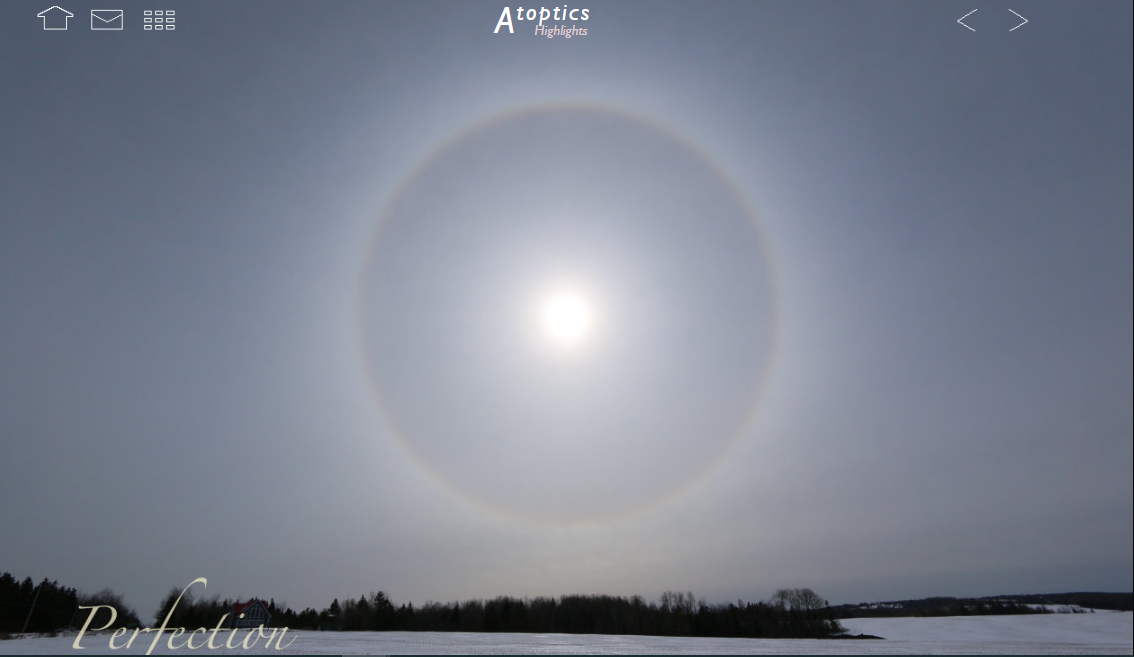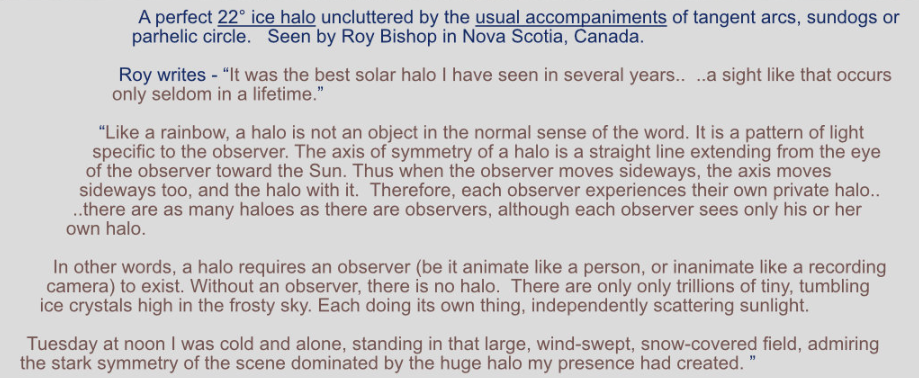Perfect 22 degree halo
The Perfect 22 Degree Halo: A Spectacular Atmospheric Phenomenon
Have you ever witnessed a perfect 22-degree halo? If not, you're in for a treat. This captivating atmospheric phenomenon is a sight to behold, with its pristine beauty and unadorned simplicity. Unlike other optical phenomena such as tangent arcs, sundogs, or parhelic circles, the perfect 22-degree halo stands alone in its magnificence.
One lucky observer, Roy Bishop, had the privilege of witnessing this extraordinary sight in Nova Scotia, Canada. He described it as the best solar halo he had seen in several years. Such a spectacle is a rarity, occurring only seldom in a lifetime.
The Unique Nature of Halos
Before we delve into the specifics of the perfect 22-degree halo, let's understand the nature of halos in general. Like rainbows, halos are not tangible objects but rather patterns of light that are specific to each observer. The axis of symmetry of a halo is a straight line extending from the observer's eye towards the Sun. As the observer moves sideways, the axis and the halo move accordingly. Hence, each observer experiences their own private halo. In essence, there are as many halos as there are observers, even though each person can only see their own.
The Halo's Formation
To comprehend the formation of the perfect 22-degree halo, we need to consider the role of ice crystals in the atmosphere. Trillions of tiny ice crystals high up in the frosty sky play a crucial role in scattering sunlight and creating this awe-inspiring phenomenon. Each ice crystal independently scatters sunlight, resulting in the formation of a halo.
Contrary to popular belief, the halo is not a 22-degree diameter "ring." Rather, it appears as a disk with a hole. At its inner rim, the halo is reasonably sharp and reddish in color. From there, it gradually spreads outwards, reaching a diameter of 50 degrees and becoming dimmer as it expands. Theoretically, the halo can extend up to 50 degrees from the Sun.
The inner edge of the halo corresponds to the minimum deviation of sun rays passing through hexagonal ice crystals. These rays converge to form a bright caustic, akin to that of a rainbow. Rays entering the crystal at different angles deflect more, giving rise to the suburbs of the halo. This dispersion of light creates the outer regions of the halo, where rays experience significant deflection.
The Personal Experience
As an observer, your presence is integral to the existence of a halo. Whether you are an animate being like a person or an inanimate recording camera, a halo requires an observer to come to life. Without an observer, there would be no halo—only those countless ice crystals tumbling independently in the sky.
Imagine standing alone in a vast, snow-covered field on a cold Tuesday noon, admiring the stark symmetry of the scene dominated by the colossal halo you have created through your mere presence. Such an experience is both humbling and exhilarating, reminding us of the intricate wonders that surround us in the natural world.
Capturing the Perfect 22 Degree Halo
For those fortunate enough to witness a perfect 22-degree halo, capturing its ethereal beauty can be a rewarding endeavor. Photography enthusiasts armed with tools like Affinity Photo & Designer can immortalize this extraordinary phenomenon. These software applications enable photographers to create stunning visuals, even during challenging times such as the corona crisis.
In conclusion, the perfect 22-degree halo is a mesmerizing atmospheric optics phenomenon that enchants observers fortunate enough to witness its splendor. Its uncluttered simplicity and symmetrical beauty make it a sight to behold. Remember, as you gaze upon this captivating spectacle, that you are not merely observing a physical object but rather a unique pattern of light that exists solely for you. Embrace the rarity of such an occurrence and revel in the wonders of our natural world.


A perfect 22° ice halo uncluttered by the usual accompaniments of tangent arcs, sundogs or
parhelic circle. Seen by Roy Bishop in Nova Scotia, Canada.
Roy writes - "It was the best solar halo I have seen in several years....a sight like that occurs
only seldom in a lifetime."
"Like a rainbow, a halo is not an object in the normal sense of the word. It is a pattern of light
specific to the observer. The axis of symmetry of a halo is a straight line extending from the eye of the observer toward the Sun. Thus when the observer moves sideways, the axis moves
sideways too, and the halo with it. Therefore, each observer experiences their own private halo..
..there are as many haloes as there are observers, although each observer sees only his or her
own halo.
In other words, a halo requires an observer (be it animate like a person, or inanimate like a recording camera) to exist. Without an observer, there is no halo. There are only only trillions of tiny, tumbling ice crystals high in the frosty sky. Each doing its own thing, independently scattering sunlight.
Tuesday at noon I was cold and alone, standing in that large, wind-swept, snow-covered field, admiring the stark symmetry of the scene dominated by the huge halo my presence had created."


A disk with a hole - The halo is not a 22° diameter 'ring' as often stated. It's reasonably sharp and reddish at its inner rim and then spreads outwards,
50° getting dimmer and dimmer. Theoretically it extends to 50° from the sun.
The inner edge corresponds to the minimum deviation of sun rays passing through an hexagonal ice crystal. Rays concentrate there to form a bright caustic just like that of a rainbow. Rays entering the crystal at other angles deflect more to form the halo's suburbs.
A ray with a large deflection forming the halo's outer regions.
Made with Affinity Photo & Designer. During the corona crisis try them for free for 3 months or buy at half price.
Note: this article has been automatically converted from the old site and may not appear as intended. You can find the original article here.
Reference Atmospheric Optics
If you use any of the definitions, information, or data presented on Atmospheric Optics, please copy the link or reference below to properly credit us as the reference source. Thank you!
-
<a href="https://atoptics.co.uk/blog/perfect-22-degree-halo/">Perfect 22 degree halo</a>
-
"Perfect 22 degree halo". Atmospheric Optics. Accessed on November 26, 2024. https://atoptics.co.uk/blog/perfect-22-degree-halo/.
-
"Perfect 22 degree halo". Atmospheric Optics, https://atoptics.co.uk/blog/perfect-22-degree-halo/. Accessed 26 November, 2024
-
Perfect 22 degree halo. Atmospheric Optics. Retrieved from https://atoptics.co.uk/blog/perfect-22-degree-halo/.